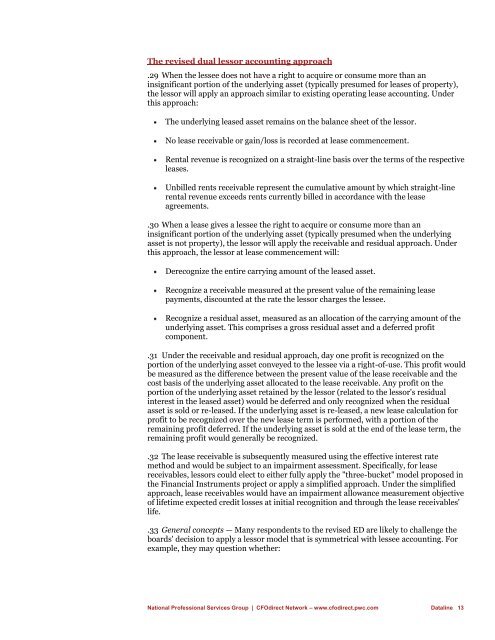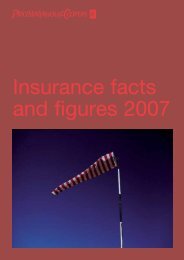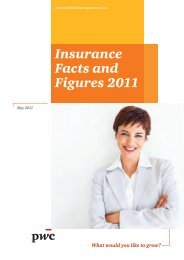Dataline A look at current financial reporting issues - PwC
Dataline A look at current financial reporting issues - PwC
Dataline A look at current financial reporting issues - PwC
You also want an ePaper? Increase the reach of your titles
YUMPU automatically turns print PDFs into web optimized ePapers that Google loves.
The revised dual lessor accounting approach<br />
.29 When the lessee does not have a right to acquire or consume more than an<br />
insignificant portion of the underlying asset (typically presumed for leases of property),<br />
the lessor will apply an approach similar to existing oper<strong>at</strong>ing lease accounting. Under<br />
this approach:<br />
The underlying leased asset remains on the balance sheet of the lessor.<br />
No lease receivable or gain/loss is recorded <strong>at</strong> lease commencement.<br />
Rental revenue is recognized on a straight-line basis over the terms of the respective<br />
leases.<br />
Unbilled rents receivable represent the cumul<strong>at</strong>ive amount by which straight-line<br />
rental revenue exceeds rents <strong>current</strong>ly billed in accordance with the lease<br />
agreements.<br />
.30 When a lease gives a lessee the right to acquire or consume more than an<br />
insignificant portion of the underlying asset (typically presumed when the underlying<br />
asset is not property), the lessor will apply the receivable and residual approach. Under<br />
this approach, the lessor <strong>at</strong> lease commencement will:<br />
Derecognize the entire carrying amount of the leased asset.<br />
Recognize a receivable measured <strong>at</strong> the present value of the remaining lease<br />
payments, discounted <strong>at</strong> the r<strong>at</strong>e the lessor charges the lessee.<br />
Recognize a residual asset, measured as an alloc<strong>at</strong>ion of the carrying amount of the<br />
underlying asset. This comprises a gross residual asset and a deferred profit<br />
component.<br />
.31 Under the receivable and residual approach, day one profit is recognized on the<br />
portion of the underlying asset conveyed to the lessee via a right-of-use. This profit would<br />
be measured as the difference between the present value of the lease receivable and the<br />
cost basis of the underlying asset alloc<strong>at</strong>ed to the lease receivable. Any profit on the<br />
portion of the underlying asset retained by the lessor (rel<strong>at</strong>ed to the lessor's residual<br />
interest in the leased asset) would be deferred and only recognized when the residual<br />
asset is sold or re-leased. If the underlying asset is re-leased, a new lease calcul<strong>at</strong>ion for<br />
profit to be recognized over the new lease term is performed, with a portion of the<br />
remaining profit deferred. If the underlying asset is sold <strong>at</strong> the end of the lease term, the<br />
remaining profit would generally be recognized.<br />
.32 The lease receivable is subsequently measured using the effective interest r<strong>at</strong>e<br />
method and would be subject to an impairment assessment. Specifically, for lease<br />
receivables, lessors could elect to either fully apply the "three-bucket" model proposed in<br />
the Financial Instruments project or apply a simplified approach. Under the simplified<br />
approach, lease receivables would have an impairment allowance measurement objective<br />
of lifetime expected credit losses <strong>at</strong> initial recognition and through the lease receivables'<br />
life.<br />
.33 General concepts — Many respondents to the revised ED are likely to challenge the<br />
boards' decision to apply a lessor model th<strong>at</strong> is symmetrical with lessee accounting. For<br />
example, they may question whether:<br />
N<strong>at</strong>ional Professional Services Group | CFOdirect Network – www.cfodirect.pwc.com <strong>D<strong>at</strong>aline</strong> 13

















